Activity 4: Battle for Fish
Topic: Youth will play a coordinate grid game to simulate the act of attempting to find fish and then ‘catching’ a population once it is found.
Time: This lesson should take approximately 45-60 minutes to complete.
Video: Activity 4: Battle for Fish (YouTube)
Learning Outcomes:
At the end of this activity, youth should be able to…
- Simulate the process of catching fish once they are found.
- Define what bycatch is.
Background Information for Facilitator:
Before fish are caught, they have to be found. One way fish are found is by using sonar technology, a technology that was explored in the previous lesson. Finding one fish can mean there is a whole population (one fish → many fish). When catching large amounts of fish, there is a potential consequence of bycatch. Bycatch are the organisms caught while fishing that were not intended to be caught. Anything can be bycatch, whether it’s dolphins or sea turtles that have accidentally been caught or the hundreds of fish thrown back after quotas have been reached. Bycatch is one factor that can make fisheries and fishing unsustainable, but efforts can be made to combat bycatch.
Materials:
- Pony beads (10 per youth)
- Coordinate grids

- Bycatch grids
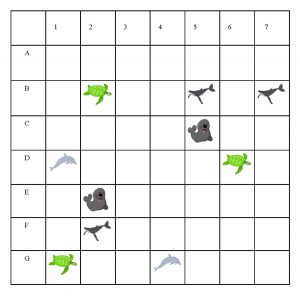
- Whiteboard or poster paper
- Folders (1 per youth)
- Dry erase markers
Vocabulary:
- Bycatch = the unwanted fish or other marine species that are caught unintentionally while trying to catch another type of fish.
Methods:
Engage
- It is difficult to find fish and other aquatic species in water because bodies of water are so big! Not only do they stretch far but they can also be very deep.
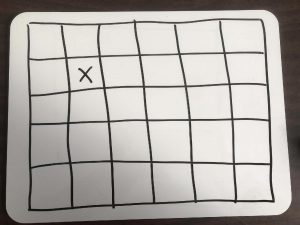 Draw a grid on the board. Then mark one of the squares.
Draw a grid on the board. Then mark one of the squares.
- Ask youth how they would communicate where the mark is. “How would you describe its location?”
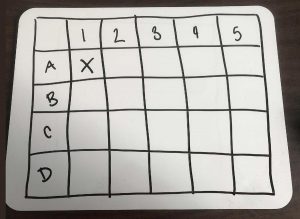 Add numbers to the top of the grid and letters to the side of the grid.
Add numbers to the top of the grid and letters to the side of the grid.
- “This time can you use the letters and numbers to describe the square with the location of the mark?”
- Practice. Change the location of the mark and ask again.
- If youth understand the concept of using a grid, let them know they’ll be using this skill for the next activity. If they are not understanding the concept, explicitly explain how to use the letters first and then the numbers (ex. E6) to describe a mark’s location.
Explore
- Split youth into pairs.
- Distribute the plain coordinate grid, folder, and 10 beads to each youth. The folders are to create a barrier so their partner can’t see their sheet.
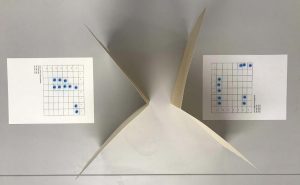 Explain to the youth that they are going to be playing a coordinate game where they are going to be looking for fish. Youth may notice that this game is similar to another popular game they have played.
Explain to the youth that they are going to be playing a coordinate game where they are going to be looking for fish. Youth may notice that this game is similar to another popular game they have played.
- First, youth use the beads provided to create 3 different fish populations on their sheet, a population of 5, 3, and 2. The populations of fish have to be ‘connected’, going either vertically or horizontally. See the example below.
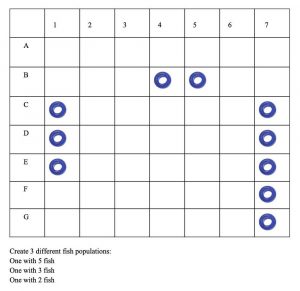
- Have youth play rock paper scissors to decide who goes first. Note: If you have an odd number of students, this game still works (youth A asks youth B, youth B asks youth C, youth C asks youth A).
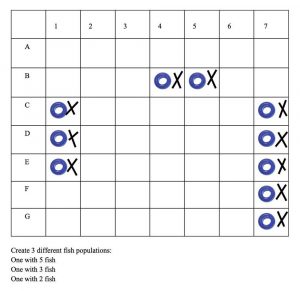 The first person to go will call out a number and letter that correspond to the grid. If the partner has a bead (or fish) on that space, they take it off, symbolizing that the fish was caught. If the person whose turn it is catches a fish, they are able to take another turn. If they do not catch a fish, it’s the other person’s turn.
The first person to go will call out a number and letter that correspond to the grid. If the partner has a bead (or fish) on that space, they take it off, symbolizing that the fish was caught. If the person whose turn it is catches a fish, they are able to take another turn. If they do not catch a fish, it’s the other person’s turn.
- Explain to the youth that they can use the dry erase marker to record where they have guessed (putting an X) and which guesses they caught a fish (putting an O). This will help ensure they don’t guess the same spot more than once. See the example to the right (or share slide 5 in the slideshow with youth).
- Continue to play.
- First, youth use the beads provided to create 3 different fish populations on their sheet, a population of 5, 3, and 2. The populations of fish have to be ‘connected’, going either vertically or horizontally. See the example below.
- Bring the group back together to discuss.
- “What emotions or feelings did you experience during this activity?”
- “How did you feel when you caught the 5 fish population compared to the smaller populations?”
- “How did you feel when you guessed and it was not a catch?”
- “What was easy about this activity?”
- “What was challenging about this activity? Why? How did you solve it?”
- “What strategies did you use to find fish?”
- For example, if youth caught fish in one spot did they continue to guess around that spot? Why not guess somewhere random?
- “What emotions or feelings did you experience during this activity?”
Explain
- “What event does this activity model?” “How does this activity relate to real life?”
- Youth are modeling catching fish. Facilitators should be sure to explain this if it does not emerge from youth, the concept of modeling for scientific practice is important.
- “What is the cause and effect of this event?”
- “What is a cause that would make you fish?” Maybe it’s your job, you’re hungry, feeding your family, or maybe it’s for fun.
- “What is the effect of the event?”. The effect is that you are catching fish, removing them from their habitat and aquatic system. Reasons that you may catch fish are feeding for your family, income, or pleasure.
- Depending on what youth bring up in their answers above, you may want to explain in detail what the activity models: This activity simulates what happens when we, or fishermen, fish. If we cast a line or net into an area and don’t catch any fish (blank space on the grid), we try another spot. Once we find fish somewhere we continue to fish in that spot, hoping it’s a big population.
Elaborate
- Explain to the youth that they are going to battle for fish again, but this time you’re going to slide a bycatch grid behind the original grid. Don’t look!
- Have youth play the game using the same rules as before.
- After they have completed the game, have the youth take the ‘bycatch’ grid out from behind the one they used to play with.
- Explain that the squares with animals in them that correspond to the ones with marks on them (where they attempted to catch fish) symbolize bycatch.
- Explain various forms of bycatch: (1) species that were not intended to be caught, but were on accident, (2) fish that were thrown back because quotas have been filled, are too small or too big, and (3) protected species that have to be thrown back.
- When fishermen cast their nets into fish populations that they have found, depending on the nets and methods they use, sometimes they collect species they don’t want. For example, casting a big net with small holes may cause you to collect an endangered sea turtle or fish that are too small to be sold, but cannot escape through the small holes in the net. You can also share the Marine Stewardship Council video on bycatch in the Additional Resources section.
- The bycatch grids youth have in front of them actually simulate the bycatch that occurs in real life. About 20% of fish caught by fisheries are discarded before they reach the port. The bycatch on the grids is on ~20% of the squares (10 out of 50).
- The animals on the bycatch grid are some examples of species that are impacted by bycatch. For example, about 150 sea turtles are caught every day.
- “Did any of you have bycatch?”
- “How does that make you feel?” “What might play into your fishing strategy as a result of this experience?”
- Have youth think about cause and effect again: “What is the cause and effect of the model now?”. The cause of the event, fishing, maybe the same as before, but now the effects are larger. Not only are targeted fish being caught but also bycatch.
Evaluate
- “What did you learn about life through this activity?”
- “Why would it be important to have strategies, or familiarity with fishing practices, when catching fish? Can you think of other instances where this might be helpful?”
- “Can you think of any ways fishermen could reduce bycatch?”
- The Marine Stewardship Council video shares two ideas: (1) modifying the size of the holes in the nets and (2) using bright colors on the nets to ward off seabirds.
Extension
- Species range connection: If youth completed the ‘Species Range’ lesson, discuss with them how including temperatures or areas of freshwater and saltwater on the map would change the game.
- Including a species range on the grids would limit where you could put a species and would narrow down your search for that species.
- Bycatch: Explore ways in which fishermen could reduce bycatch.
- Think about the way nets are created and the size of the holes. “Can they be individualized for the type of species being caught?”
- “Besides nets, what other ways could we reduce bycatch?”
Additional Resources:
- This is a 1-minute video (good one to show students) from the Marine Stewardship Council – Sustainable seafood which quickly explains what bycatch is, why it happens, and how some fishermen are changing their techniques to help solve the problem: What is bycatch and how can it be managed? (YouTube)
- This is a PDF document produced by Oceana, March 2014 (Authors: Amanda Keledjian, Gib Brogan, Beth Lowell, Jon Warrenchuk, Ben Enticknap, Geoff Shester, Michael Hirshfield, and Dominique Cano-Stocco) explains what bycatch is and why it’s a problem in U.S. fisheries: Wasted Catch: Unsolved Problems in U.S. Fisheries (PDF)
Supported by National Science Foundation award #OIA-1849227 to
Maine EPSCoR at the University of Maine.

This project is part of the RII Track-1: Molecule to Ecosystem: Environmental DNA as a Nexus of Coastal Ecosystem Sustainability for Maine (Maine-eDNA) at the University of Maine.
